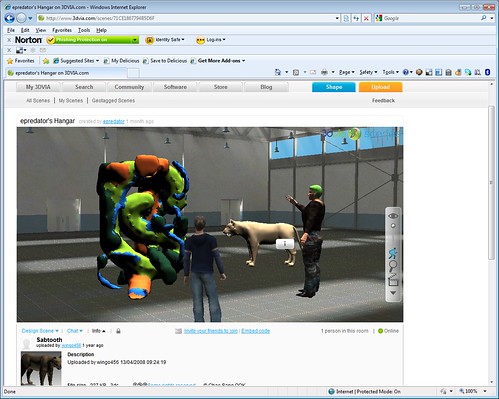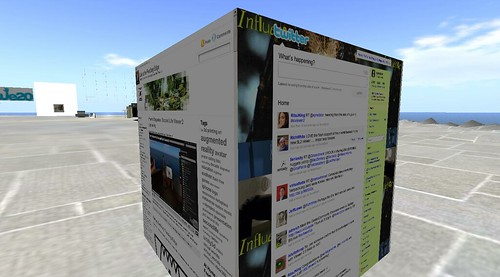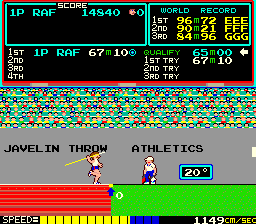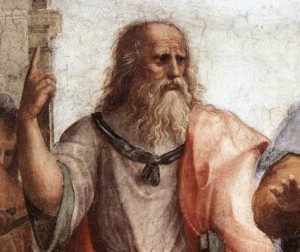I finally got to switch on my windows machine and try 3dvia scenes. 3Dvia is a collection of uploaded multi-format 3d models that has an interesting iphone app to go along with it which I had mentioned in a few posts
Now there is an extension to the web site called Scenes. This allows you to create a “room” or a place and drop in the 3d content from the library. You have an avatar based experience in the browser plugin wandering around your room, other can join you for chat and also be allowed to edit things.

This worked really well (once my flaky windows vista machine started up). So my only complaint (or wish) is that this would be a cross platform plugin like unity3d is. *Update it may well be it just did not work. The 3d model player does work (though in firefox not safari, but the places player is a .exe at the moment I think)
The content in this scene shows the variety of sources.
The character on the right is the exported version of my Evolver avatar (though it is a static 3d model in this case)
The sculpture on the left is one that I doodled on my iphone with sculptmaster
The wild animal is someone elses, I left the description panel in the picture as you just drag and drop from the search to keep the credit in place.
The figure in the centre is an animated walking moving avatar in world.
D’assault Systemes are certainly doing a good job for us in showing the ability to transfer and interact with pure 3d content.
future
Mashing up web and Second Life Viewer 2
We have always (as land owners) had the ability to set video parcels in Second Life. This has of course been a bit of a pain with only one video stream, or web page display allowed per parcel. Now we have new media sharing abilities. This has already been implemented in some of the other platforms, but most of those are less user generated in their content.
I tried a few extensions out to ideas, in particular powered by the fact that SL will play interactive flash now not just flash movies as before.
http://www.text2mindmap.com http://www.duckfeetdesigns.com/flocking.htm and http://www.habbohotel.co.uk
I used a mind map tool on the web and mashed it with wearing a sphere for a presentation. i.e. you can wear interactive web applications now
I dropped myself into a flash based flocking display where I controlled the direction of the fish.
Finally I popped into Habbo Hotel.
There are of course a few issues and gotchas with interacting with flash. The experience is not totally shared. The browser URL is shared, but not all the interactions. This is only to be expected. I am not complaining, but I know that this will confuse some people. A web interface is inherently single user even if there are multiple users of a system.
Loggin in and personalizing your view of a system is not going to change others views unless the controlling website knows whats going on with this virtual world and multiple users hitting it in context.
There are a lot more things we can do now though, website based HUD’s(I have a transparent twitter hud on right now), textures stored off world (though we are limited to 8 player surfaces at the moment so this could get clunky).
With the combination of SL being able to create HTTP Server objects too we have quite a loop of connectivity.
This is very exciting stuff as many of the projects over the years that I have been involved in move data around and in and out. Things got a whole lot easier I think.
Posting from Second Life Viewer 2
As we were all given access to Second Life viewer 2 just now (not sure why I missed out on the closed beta, but no matter) I thought I would try the full web page on a prim.
This picture I took from within world of me tweeting on the side of a prim whilst also browsing this blog

In fact I wrote this post on the side of a prim. So it works(I posted it live from a normal webpage, it should have worked but just dropped into draft 🙂 nothings perfect)
# slviewer2 is very exciting stuff once you get past the chat window moving around!
**Update I also sparked up habbo hotel on a prim and that worked fine (as its just flash). Its a pity Metaplace isn’t there as we would have had some interesting cross media experiences there too.
It has made the interacting with existing content very very easy. Whiteboards, brainstorm tools, videos, etc. All very powerful.
Happy Birthday Feeding Edge
Today it is 1 year since Feeding Edge started to take a bite out of technology so you don’t have to.

I have to say that my first year as an entrepreneur not and intrapreneur has been quite learning experience, though at the same time a familiar one.
There have been lots of interesting meetings and conversations, ideas for projects, requests for help. There has been an awful lot of doing things that needed doing without an obvious and direct payback. Out here in entrepreneur country relationships and helping one another is even more important than in corporate life.
Equally out here you are not a role or a professions. You are whatever you need to do, whatever you feel you can do, you just get on and do it.
The things I have done have crossed many technical platforms and boundaries, much of it cant be shared (which is a pity). Everyday brings a new challenge, whether that is having an idea and seeing if it is possible or talking to people and providing some insight and support to discussing funding of a project.
Do I miss the corporate life? Well after 20 years its hard not to be institutionalised. I miss the good people I worked with, the things we did that mattered in spite of those that had their own more selfish and closed agenda. We all need flags to rally around, I now have Feeding Edge, for which I have a comfortable affinity for and a multitude of projects, customers and collaborations that orbit it.
I miss the paycheck, a known entity every month, and without my wife’s support whilst we build the business and the various revenues streams (listen to me! revenue streams 🙂 ) then this year would not have been possible.
A huge thankyou goes out to all the people who have offered support, talked to me, asked for help and suggested projects.
To all my fellow metaverse evangelists we still have a way to go, but I think we can get where we need everyone to go 🙂
I figure whatever you do you always “work” for someone or something. Family, a cause, a team, shareholders. Finding the thing that sparks your brain, makes you feel engaged an interested really is the key. I have always loved what I do and that’s not changed.
So onward and upward 🙂
If you need me just come and say hello, wherever or however suits.
Linkedin
Twitter
Facebook
epredator potato in Second Life
epredator [at] feedingedge.co.uk
etc. etc. 🙂
Raph’s gamification of everything, Homo Interneticus and the Octupus
I was catching up on some blogs before jumping on a train and heading to London to discuss one of my major threads of work at the moment which could be described of gamification of a particular genre of interaction. Up on the feed reader pop’s Raph’s gamification of everything post. Its always hard to ignore serendipity when its been so vital to me over the years.
I am not going to repeat what Raph said, go and read it, but he makes a very good points that whatever your objections to the gamification of certain services, however industries, governments, leaders are using basic human psychology, paired with the communication the web gives us, this sort of interaction is not going to go away and we need to take a balanced view.
If you have ever got a buzz from receiving a level up in a game, or a promotion level at work, or a prize at a competition or a complement well meant then you already know of the impact of recognition.
Computer mediated experiences allow very quickly for new achievements to be generated for a never ending set of levels and trophies to be created. If you map that to a promotion structure in your average corporate, those events are few and far between and unable to be restructured due to legacy promotions of others. It is fairly easy though for World of Warcraft to introduce another 10 levels on top of the uber level of 70, or for Pet Society to introduce yet more rainbow poo.
Of course, as Raph points out, when these reward structures are applied to things such as parenting, politics, product use who is it who decides the structure and what are their motivations.
“There are plenty of valid concerns to be had here. But it’s not going to go away. Instead, we need to be thinking about what our accommodation is with these technologies and approaches. Almost all of this arises simply out of better knowledge of ourselves and our psychology paired with improvements in communications technology. And that is not a new problem — it’s an old one.”
“the concerns that arise from gameifying the world apply in larger measure to non-games.”
The last part of the BBC Virtual Revolution programme looked at Homo Interneticus. How we are evolving and changin the way we enagage with information and with one another. There are of course concerns to be raised but there is also the potential that we are in fact now interacting in ways that suit how our brains work, in an associative fashion rather than in a way that has been restricted by some of the ways we could interact with information before. (I took the web behaviour test BTW and came up as a Web Octopus)
It was interesting in the programme to hear Susan Greenfield refer to the dangers of online interaction for our brains. Here premise being that there are no consequences to our interactions online, because if you break something in the real world its broken, break it online and it doesn’t exist. That is of course missing quite a lot. There clearly are consequences to your online interactions. True if you play a game with respawning on, you die, you are back again. That though is like playing hide and seek as a child. You are found, you go hide again. However when you interaction is with people and their things online you have the ability to enhance or reduce the quality of the relationship with them just as much as sitting around at dinner. It is true if you understanding of physics comes solely from a simulation of physics you may be surprised at the real world results, but equally you may learn more about physics by being able to play with and experience forces that would be impossible/really hard in real life.
I did really like the video Raph posted from Stargate studios on video compositing and not believing everything we see. It’s come a long way from a bit of film projected behind an actor. Though I do find some of the street scene changes in this as a little odd. Why not just leave it as it was? Which I guess comes back to the point. Who makes the changes and why.
Virtual Nightclubs, mainstream SciFi and digital legacies
Last night saw the airing on Sky 1 here in the UK of the Battlestar Gallactica prequel Caprica. BSG was a fantastic series, and was seemingly accessible science fiction throwing in a hint of West Wing.
The first 2 episodes really set up the story as you would expect but I was not expecting the subject matter to resonate quite so much with some of the real world virtual work that we are all doing.
Caprica is set fifty or so years before BSG on a distant resembling earth in many ways. In the first programme a group of teens are engaging in attending v-clubs. Virtual night clubs. These clubs are an underground movement and accessed using a headset “holoband” to inject the photo realistic images into the users head. The places themselves are portrayed as a wild noisy and dangerous night clubs, hidden from parents knowledge.

One of the teens is the daughter of the richest man on the planet who happened to invent and create lots of the tech. She has created a clone of herself inside the virtual environment. Everyone has a physical clone, they showed the use of body scanning in a booth to get physical parameters, but this avatar (and they us that word a lot) is an artificial intelligence construct.
When the real teen is killed her AI lives on in the virtual world. We get to learn that she did not simply download here brain data to a computer core (an often used idea), but instead the AI learned who it was to be the girl through the digital trails that she had left during her life on the world. In this environment indicating that the algorithms to search and learn were clever enough to reconstruct and then move forward as a person.
The father then seeks to perform what can only be described as a Frankenstein manoeuvre, and attempts to place the AI data into a physical manifestation of a robot, or Cylon. The digital is made real.
Clearly this mainstream science fiction is informed and extrapolates todays science fact. The digital trail we leave today may not yet be enough to reconstruct our personality, but those of us who choose too are certainly leaving lots more clues as to who we are and what drives us than ever before. There are also clearly times when people’s echoes are placed out in the public domain when they did not intend them or want them to be.
I was also reminded of a interesting question I was asked when presenting at a recent conference. “What happens to your virtual presence when you die”.
OK, so we don’t quite inject virtual worlds into our brains matrix style, we don’t have fully functioning AI’s or autonomous robots to download into, but we do have ways to interact online and share who we are and what we think and do. When we no longer participate in the online experiences we still have left a legacy and digital echoes, it’s not just photos and memories anymore.
Of course just as with the film Avatar we may find a large number of people not exposed to current virtual world technology may be a little disappointed but equally many may see these parallels and start to understand the deeper significance to our online presence and why so many of us are so passionate about them.
The virtual revolution has started
This weekend on prime time BBC2 TV saw the first part of the four part documentary “The Virtual Revolution”. It is hosted by Dr Aleks Krotoski know to many of the metarati out there for studies into Social Influence in places like Second Life, and also the living the rock and roll with Jim “Babbage Linden” Purbrick and Max Williams in the band 100 Robots. Many people will have followed the #phdhell that Aleks has been tweeting about too. Also the twitter stream has been full of the production of this programme.
All this leads to the fact that it was a much watch piece of TV. I tweeted early on “This is what we have the BBC for” because it was a very well made, not too geeky and well thought out exploration of “The Great Levelling”. Many notable shapers of the web we know today featured in interviews. It will hopefully be seen by many people who seem to assume the web and social interaction and sharing of information is some how a bad thing. It isn’t. It has arrived and we have changed many of the the things we do and enhanced others by engaging with one another.

I should add that whilst the programme covers the past 20 years it should be clear to us all that we have come a long way and still have a long way to go in human communication online. It starts by embracing what we have now, to engage and explore all the possibilities. (Yes that includes virtual worlds like Second Life!). However don’t assume we have the perfect solutions yet. There is more to come than avatars, islands, Facebook friends, blogs and twitter. An underlying social change is happening though.
To quote Stephen Fry in one of the many pieces of video available on the Virtual Revolution website “we are, constantly in need of, of connecting with people for, friendship, love, sex, knowledge, growth, enmity, territoriality all the, all the imperatives that drive us as human beings. Erm we’ve created villages and towns to help us do that and roads and now we’ve created something else that allows us to do it, us to do it even more. ”
For a slightly more reactionary piece there is always John Perry Barlow on freedom of expression (who I nodded in agreement a lot with)
“I wrote a piece for Wired Magazine in, in ’93 which they called The Economy of Ideas. And I recognised that the only reason that copyright had worked was because it was hard to make a book. And that suddenly anything that a human being could do with his or her mind would be infinitely reproducible at zero cost and infinitely distributable. And given that there is a fundamental quality in human nature that likes to share information. I mean if you think something is, is cool or interesting what’s the first thing you want to do with it? Tell everybody you like. You know, and if, and if it’s not just simply saying I read this great book you should go out and buy it but you can just sort of zap the book right in to the other persons mind practically, you’re gong to do that. And you’re not going to have much regard for, for copyright. Er, and so the powers that had been suddenly saw copyright as being a splendid way to control this scary new liberty. Er, that exerting powerful controls on owned word would be the, would be the real method of clamping down on this, this thing.”
One interesting thing that happened on the starting titles, and helped the twitter buzz was seeing on screen the hash tag for #bbcrevolution. It was just placed bottom right of the screen. For many people this will seem alien, “thats not a URL”. Whilst the general public, non tech geeks, have got very used (in the past few years) to seeing a web site URL they will not have seen the meta URL that is a hashtag. The #andsometext notation is used to lift a tag or label a piece of conversation as being relevant to a subject. It is platform agnostic, you can hashtag anywhere, its just text. It means searches can find threads of conversation across disparate sources. It is not organised, controlled nor policed. It just is. To see it on a documentary that has been create through many online collaborative efforts, putting its money where it mouth is is another indication of the validity of the programme.
Sports communities in Second Life – A new satellite dish?
With all my comments on needing to engage with virtual worlds and the olympics and the work I have done up to now with online sports representations is it really great to find an exemplar of a community driven collect of sports enthusiasts.
One great example is the Global Online Hockey Association

In particular it is worth taking a look a Treet.Tv coverage of a live event held there on Jan 10th
Now there is a lot of passion and effort, plus community participation that goes into this, but when you think of the global budgets of the advertiser and sponsors of world sporting events this really is not very expensive! The same applied to Wimbledon in SL, which in reality I paid for the land and a few of us volunteered our time to build.
It is the fact that people with an interest and a passion can get an awful lot done themselves. However think about how all this could be made even better with just a little attention from an interested party.
For sports social media and virtual worlds need to enagage, for virtual worlds what could be more mainstream an example than sports? Much of the take up of Satellite TV in the UK was driven by people wanting to watch soccer.
Can virtual worlds and online interaction be the new Satellite dish?
Crowdsourced digital recreation of Olympics 2012?
I managed to get this idea into a tweet of 140 characters. Which I guess means that its not too bad an idea and easy to explain. The original text was
“2012 olympics spectators to share their videos. Pump video into project natal. Mocaped events rerendered in vw. Bypass agencies”

Image from Konami Track and Field at arcade-history.com
To explain the how and the why of this a bit more now the elevator pitch is done.
The London 2012 olympics is a huge event that will be taking place in a world that is already heavily immersed in social media. People are already willing to take photos, share their experiences. A mass event like the Olympics will mean huge numbers of people sharing that experience from their mobile devices at the event.
On the other hand we have an event that has lots of international politics around it, huge sponsorship deals to guarantee coverage and to also pay for the logistics of the event.
We want 2012 to be the best games ever. However we are in a cash strapped world coming out of a major recession.
One of the things I have majored on over the past few years is the recreation of sporting events (and other training events too) from data and descriptions of the event. This is in part a technical interest but also one where I know that sport is understood by most people, so representation of sport in new ways helps them understand things like virtual worlds, social media and games.
I got to thinking that if the various bodies and rights management people controlling the Olympics flow of content and data have the whole thing locked down, negotiated and controlled but are not doing anything forward thinking now using the emerging technologies then we need another option.
A crowdsourced and opensource approach may just be one that at least demonstrates the potential power of the crowd covering the event.
The basic premise.
2012 a high percentage of people able to attend the olympics either on corporate tickets or paid for will have good mobile equipment, cameras etc. Network coverage will be good as it will be boosted for the event too. So there will be a vast amount of tweets, pictures, videos, streaming video, blog posts, facebook chat etc flowing in and around the events. That will of course not be as good as the TV company coverage but it will still have a great deal of potential.
Taking some of those images, videos etc and utilising technology to work out which athlete is where, what event was this, and even motion capture the individuals at events using Project Natal (like) technology means we have a great deal of data available to digitally recreate the games in the public domain. Its the sort of approach Photosynth takes to recreate imagery from mass use of digital media. To feedback to the crowds with data driven augmented reality applications etc. It is a little way out, but it is not impossible and there is a lot of technical and social innovation that can occur in the next 2 years with web, mobile, virtual worlds and games.
I think London 2012 needs a focussed and serious look at the things that can have a huge impact to the coverage and popularity of the games. The things I am considering here are homebrew ideas. They can be done very cheaply by anyone. Their is huge scope for something much greater to be done for very little extra cost and effort in the scheme of things by the powers that be.
Capture, Analyse, Recreate, Share. Yes CARS for the olympics.
Plato, a clever bloke.
I have seen this quote by Plato flying around a lot recently. It is particularly apt and correct when trying to help people come to terms with the benefit of gameplay in all fields.
“You can discover more about a person in an hour of play than in a year of conversation.”

Now bear in mind we have the ability to play and interact with one another on all sorts of digital channels. Social media is about conversation of course, but it is also the social side of gaming, be that a dedicated game or people choosing achievements that mean something to their friends and playing, competing and cooperating. e.g. unusual photo competitions on flickr.
Imagine too that we are playing multiplayer games. So you get to learn more about several people in 1 hours gameplay online than several years worth of individual conversation.
The amount that we reveal about who we are online through these gaming, and in the case of virtual worlds semi-gaming experiences should not be underestimated as a powerful reason to interact. The institute of the future has a post on Avatar Maximization around how people react to us and our digital representations.
This is not really just about identity, though its clearly a subject to consider as we see on New World Notes about real life versus made up vs augmented names. It is about what happens when humans communicate in ways other than purely talking face to face.
Discovering more about motivations, styles of operating and preferences do shine through in our gameplay. Games of all sorts help put people at ease and when at ease their true self shines through. Not all games of course, in poker the aim is to not give anything away and keep that poker face. However, the method by which you control your “tell” or discover others is equally enlightening.
I suggested in my predictions that Games as Work is a way forward and it would appear that Plato agrees (sort of).
It could well be that with fantastic creative tools like Unity3d and virtual world toolkits like Opensim we will indeed see even more “gamification” as David Helgasson Unity3d CEO has suggested
That can only be a good thing for understanding our colleagues, friends and competitors.
